This story originally appeared on Underscore.news.
Last week, a tattered blue mattress and mounds of trash littered the entrance to the Chemawa Cemetery – the final resting place of approximately 175 of the 270 Chemawa students who died while under the care of the school between 1880-1945.
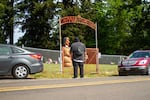
On Memorial Day, dozens of volunteers gathered at the Chemawa Cemetery to honor and clean the graves of the 175 children who died while under the care of the school. Photo taken on May 27, 2024.
Jarrette Werk / Underscore News
On Memorial Day, dozens of volunteers, including descendants of Native American boarding school survivors, Native community members, allies, and former Chemawa Indian School staff and students gathered to clean up the neglected Chemawa Cemetery, as it had become an overgrown dumping ground.
Over 125 years old, Chemawa Indian School is the oldest continuously operated boarding school for Native American students in the United States. According to the Bureau of Indian Affairs, the school saw peak enrollment in 1926 at almost 1,000 students.
“When you visit there, it’s like, ‘Holy cow, there’s all these kids. What happened to them and why are they so neglected? Why is this place so ugly?’” said John Spence, who helped organize the clean-up on Monday morning.Spence, 83, (Gros Ventre / Sioux) Aaniiih Citizen of the Fort Belknap Indian Community in Montana, is a tribal horse therapy consultant at the Native American Rehabilitation Association Northwest. He earned his doctorate in higher education from University of Washington in 1987. The staff and kids he works with call him “Uncle John.”
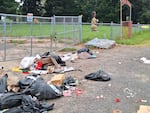
The entrance to the Chemawa Cemetery, photographed on May 22, 2024, was littered with mounds of trash and a tattered old mattress. "This is heartbreaking," said John Spence.
Courtesy of John Spence / Underscore News
Spence worked as a substance abuse counselor at Chemawa for seven years, from 1988 to 1995. Decades later, he discovered that his birth parents met while attending school at Chemawa.
Although Spence’s mother died when he was three and he never met his father, he and his two sisters were raised by their grandmother on the Fort Belknap Reservation in Montana, where his grandmother attended another boarding school: St. Paul’s Mission.
Spence says he has a hard time understanding why his grandmother decided to send her daughter more than 950 miles away from home, knowing what she endured to receive an education.”I have no idea why she didn’t tell us why they came all this way, and what happened here,” Spence shared with the group during the talking circle. “Especially with my grandmother and what happened to her at the [St. Paul’s Mission] school. Why did she send my mother [here]?”Like many in attendance on Monday morning, Dr. Spence’s connection to Chemawa runs deep and it keeps pulling him back.
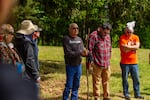
John Spence, Gros Ventre and Sioux, worked at Chemawa for seven years as a substance abuse counselor. When he visited the cemetery last summer he noticed how neglected it had become. That spurred him to help organize the cleanup this year.
Jarrette Werk / Underscore News
“I hadn’t been here for several years, and I came back last summer to see the condition of this place, and to see what it was before, to now, it’s really heartbreaking,” Spence said.
Seeing the neglect of this sacred place is what motivated Dr. Spence to contact Kevin Simmons and Valdez Bravo from the Democratic Party of Oregon Native American Caucus. Together, the three organized this cleanup and honoring for the children who never made it home.
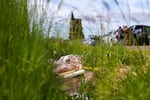
The ditch in front of the Chemawa Cemetery was littered with trash and other discarded household items. Dozens of volunteers gathered on Memorial Day to remove the trash, clean headstones and pray for children who never made it home.
Jarrette Werk / Underscore News
'A gut punch’
On Monday morning, as volunteers parked their vehicles along the overgrown and litter-lined Indian School Road they were greeted by blue skies and the sounds of spring songbirds. The tall grass swayed as the wind picked up, revealing a styrofoam cooler and plastic bags containing more trash in the ditch. Faded red prayer cloths and a row of yellow ribbons tied on the chain-link fence danced in the breeze as volunteers walked by with tools and gloves in hand.
Like Spence’s parents, Tamzyn “Tam” Alzyout’s grandfather also attended Chemawa as a small child through his early teen years. Alzyout, Tlingit & Haida from Southeast Alaska, said walking into the cemetery on Monday morning was “unnerving” and that it “hurt.”
Fortunately, her grandfather survived Chemawa. But that wasn’t the reality for many Alaska Native children who were taken from their families as young as 6 years old. Many now lie buried in this small patch of land in between Interstate 5 and busy train tracks, hundreds of miles away from their families.
An old red metal archway reads “Chemawa Cemetery.” Dated to 1886, it’s locked with an old rusty padlock. A separate side entrance opens up into the cemetery. Walking through the opening, Alzyout’s first steps inside were atop a small headstone. The metal nameplate had a familiar name, one that she has familial ties to.
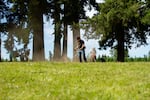
Dozens of volunteers brought landscaping tools to help uncover the overgrown headstones of the 175 students who are buried in the Chemawa Cemetery.
Jarrette Werk / Underscore News
“Coming in and seeing the Kennedy name was like a gut punch, because what if this is one of my relatives, and it’s the first thing you step on if you’re not looking for it,” Alzyout said, referencing to the small headstone with a misspelled first name that lays in the center of the cemetery entrance. ”It’s just unnerving,” she added. “If this was a Eurocentric cemetery, it wouldn’t be like this.”
Chemawa Indian School
Chemawa Indian School is a federal boarding school for Native American students that first opened as the Forest Grove Indian Industrial Training School in 1880 with the goal to eradicate Indigenous culture. In 1885, the school was moved to its current location in Salem, Oregon.
According to the National Native American Boarding School Healing Coalition, during the 19th and 20th centuries, Indigenous children were forcibly abducted by government agents and sent to one of the more than 523 government-funded, and often church-run, Native American boarding schools in operation across the U.S.
Indigenous children were ripped away from their families, stripped of their culture, had their hair cut, and were punished for speaking their language, all in hopes to assimilate them into western culture.
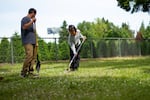
Former Chemawa students showed up to help clean graves on Memorial Day
Jarrette Werk / Underscore News
Although Chemawa is still in operation today, it is a much different place than its dark past.”It’s more like an alternative school now than the old abusive style of boarding school era,” Spence said.
According to the website, the mission has changed some over the years, but the goal to educate Native American students for the world outside has remained the same.
Cleaning graves
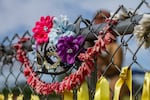
A string of faded prayer cloths tied to the chain link fence of the Chemawa Cemetery.
Jarrette Werk / Underscore News
On Monday, the group of volunteers gathered near the entrance for an opening prayer and introductions and shared their personal connection to Chemawa and other Native American boarding schools. One by one, they expressed how they wanted to be there to honor and remember the children and relatives who never made it home. ”I know that some people from my tribe came up here, I don’t know if any are here in this cemetery, but there could be,” one elder shared.
As each person shared, one man walked around with burning sage, smudging everyone in attendance, before smudging the perimeter of the cemetery.
“In my language, we have a word ‘Gonohkwa’ that means ‘relatives,’ and ‘Kenohkso,’ that means ‘I love you.’ I’m here because I love my relatives,” Jim Wikel, Seneca-Cayuga Nation, said with a shaky voice. “This is heavy.”
Kevin Simmons, Grand Ronde and Muckleshoot, is also a product of Chemawa. His grandparents met there in the 1920s, and his son also met his girlfriend there before graduating. He wanted to help Dr. Spence organize the event.
Like Spence, Kevin Simmons also worked at Chemawa, in the special education program from 2015 to 2018. He currently serves as the chair of the Native American Caucus for the Democratic Party of Oregon and is a fifth-year doctoral student focusing on Indigenous education at the University of Oregon.
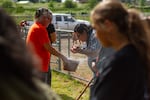
While volunteers made introductions and shared their personal connections to Chemawa and other Native American boarding schools, one elder held a terracotta planter filled with burning sage and smudged everyone in attendance.
Jarrette Werk / Underscore News
“From the time that I worked here, I’ve known that I literally will walk in these footsteps with these kids,” Simmons said. “And so much of what we’re doing, whether it be education or tribal work, that these kids and these youth that attended, we walk in their footsteps.”

Kevin Simmons, Grand Ronde and Muckleshoot, holds up a yellow rose during the talking circle, explaining how each grave will be cleaned and prayed for and roses will be placed on each headstone.
Jarrette Werk / Underscore News
Like Simmons, Wikel is also a child and grandchild of boarding school survivors. His grandfather was sent to the Seneca Indian Boarding School when he was a young boy.
“He was there until he was 14. My auntie, his sister, passed away while she was there, and they didn’t even tell him until he came home for a holiday,” Wikel said.
Wikel said that his grandfather, like many survivors, never talked about what happened during his time at boarding school. Partly because he said his grandfather wanted to forget. But, he added, this is an important part of history that must be remembered.
“While we say history, it’s still living history, we’re all still here. We’re all still a part of it,” Simmons said. “No matter what community you’re from, we all have a connection to this history of boarding schools, and its impact on our nations and our people and our families.”
Remembering the lost children of Chemawa
After the graves were all cleared, name tags were cleaned, flowers placed on headstones and prayers and offerings were made, Alzyout sat under the shade of a large tree. She recalled a story she heard from a Tlingit elder who had a dream where they were in a canoe filled with people. Some of the seats had bright and lively rainbow children while others were sad and almost transparent.
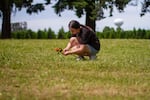
Liora Hill, 14, Klamath, Modoc and Kikapoo, said prayers for each child as she placed roses on headstones. "They were just kids, they didn't get to live their lives, and that's just sad to me," Hill said. "I wanted to come here to honor them because I would hope someone would do it for me."
Jarrette Werk / Underscore News
“The ones that are sad and transparent are the ones that don’t have anyone talking or remembering them,” Alzyout said. “The ones that are lively and vibrant, that’s because someone is talking about them and remembering them. And it made me think of all these young children, who is remembering them? Is anyone left to remember them?”
While it’s hard to say who the living relatives are of the lost children of Chemawa, one thing was for certain on Monday: each child was prayed for, loved and remembered, in hopes that they are now vibrant rainbow children.
Underscore News is a nonprofit investigative newsroom committed to Indigenous-centered reporting in the Pacific Northwest. We are supported by foundations and donor contributions. Follow Underscore on Facebook, Twitter, Instagram and TikTok.